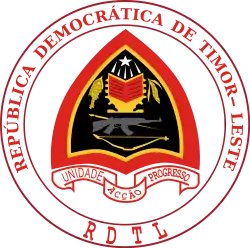Constitution of East Timor
The Constitution of East Timor entered into force on 20 May 2002, and was the country's first constitution after it gained independence from Portugal in 1975 and from Indonesia, which invaded East Timor on 7 December 1975 and left in 1999 following a UN-sponsored referendum.
| Constitution of the Democratic Republic of East Timor Portuguese: Constituição da República Democrática de Timor-Leste Tetum: Konstituisaun Repúblika Demokrátika Timor-Leste | |
|---|---|
.jpg.webp) Preamble and article 1. | |
| Created | 2002 |
| Ratified | 20 May 2002 |
| Author(s) | Constituent Assembly of East Timor |
| Signatories | Constituent Assembly |
| Purpose | National constitution |
 |
|---|
| This article is part of a series on the politics and government of Timor-Leste |
| Constitution |
|
|
History
The Constitution was drafted by the Constituent Assembly elected for this purpose in 2001. Pursuant to an UNTAET regulation,[1] the constitution did not need support in a referendum, but entered into force on the day of independence of East Timor after it was approved by the assembly.
There are two versions of the Constitution, one in each of the country's official languages, Tetum and Portuguese.
The Constitution consists of seven parts, namely:
- I. Fundamental principles
- II. Fundamental rights, duties, liberties and guarantees
- III. Organisation of political power (including the provisions about the three branches of government)
- IV. Economic and financial organisation
- V. National defence and security
- VI. Guarantee and revision of the Constitution
- VII. Final and transitional provisions
External links
- Text of the Constitution in English:
- http://timor-leste.gov.tl (pdf)
- www.constituteproject.org (pdf)
- Text of the Constitution in Portuguese (pdf)
- Text of the Constitution in Tetum (pdf)
This article is issued from Wikipedia. The text is licensed under Creative Commons - Attribution - Sharealike. Additional terms may apply for the media files.